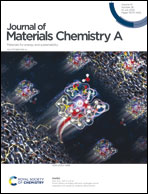Interfacial effects in an inorganic/organic composite based on Bi2Te3 inducing decoupled transport properties and enhanced thermoelectric performance†
Abstract
An inorganic/organic composite is suggested for low-temperature thermoelectric applications. An abundant and inexpensive conducting polymer, poly(3,4-ethylenedioxythiophene):poly(styrenesulfonate) (PEDOT:PSS), is introduced into n-type Bi2Te3, thus affording a bulk-phase composite, in which an interfacial energy barrier may occur at the component interfaces. These interfaces interfere with charge carrier transport, and thus the composite exhibits somewhat higher electrical resistivity than pristine Bi2Te3. However, the interfacial energy barrier can cause an energy filtering effect; thus, the composite exhibits a higher Seebeck coefficient than the pristine Bi2Te3. This Seebeck coefficient improvement is high enough to compensate for the resistivity increase, and thus the composite affords a significantly higher power factor than Bi2Te3. The composite exhibits lower lattice and carrier thermal conductivities than Bi2Te3, because the composite includes the interfaces possibly causing vigorous phonon scattering, and it exhibits relatively low carrier mobility. The composite is observed to show much lower total thermal conductivity than Bi2Te3. Consequently, the electrical and thermal properties are decoupled in the composite, resulting in remarkably enhanced thermoelectric performance (ZTmax ∼ 1.19@132 °C; ZTave ∼ 1.14@50–150 °C), which is approximately double that of Bi2Te3. Not only are the ZT values predominant among those of n-type Bi2Te3 analogues but they are also as competent as those of n-type Bi2Te3-based ternary substances. The composite is expected to be an excellent counterpart of p-type Bi2Te3, and thus it should be highly applicable to promising low-temperature thermoelectric operations, such as sustainable energy harvesting devices and systems.



 Please wait while we load your content...
Please wait while we load your content...